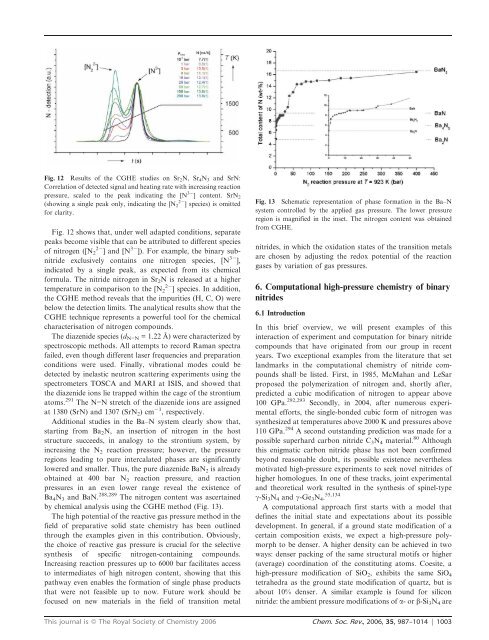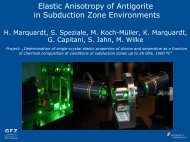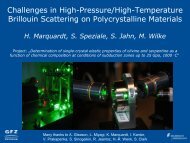High-pressure chemistry of nitride-based materials
High-pressure chemistry of nitride-based materials
High-pressure chemistry of nitride-based materials
Create successful ePaper yourself
Turn your PDF publications into a flip-book with our unique Google optimized e-Paper software.
Fig. 12 Results <strong>of</strong> the CGHE studies on Sr 2 N, Sr 4 N 3 and SrN:<br />
Correlation <strong>of</strong> detected signal and heating rate with increasing reaction<br />
<strong>pressure</strong>, scaled to the peak indicating the [N 32 ] content. SrN 2<br />
(showing a single peak only, indicating the [N 2 22 ] species) is omitted<br />
for clarity.<br />
Fig. 12 shows that, under well adapted conditions, separate<br />
peaks become visible that can be attributed to different species<br />
<strong>of</strong> nitrogen ([N 22 2 ] and [N 32 ]). For example, the binary sub<strong>nitride</strong><br />
exclusively contains one nitrogen species, [N 32 ],<br />
indicated by a single peak, as expected from its chemical<br />
formula. The <strong>nitride</strong> nitrogen in Sr 2 N is released at a higher<br />
temperature in comparison to the [N 22 2 ] species. In addition,<br />
the CGHE method reveals that the impurities (H, C, O) were<br />
below the detection limits. The analytical results show that the<br />
CGHE technique represents a powerful tool for the chemical<br />
characterisation <strong>of</strong> nitrogen compounds.<br />
The diazenide species (d NLN = 1.22 s) were characterized by<br />
spectroscopic methods. All attempts to record Raman spectra<br />
failed, even though different laser frequencies and preparation<br />
conditions were used. Finally, vibrational modes could be<br />
detected by inelastic neutron scattering experiments using the<br />
spectrometers TOSCA and MARI at ISIS, and showed that<br />
the diazenide ions lie trapped within the cage <strong>of</strong> the strontium<br />
atoms. 291 The NLN stretch <strong>of</strong> the diazenide ions are assigned<br />
at 1380 (SrN) and 1307 (SrN 2 )cm 21 , respectively.<br />
Additional studies in the Ba–N system clearly show that,<br />
starting from Ba 2 N, an insertion <strong>of</strong> nitrogen in the host<br />
structure succeeds, in analogy to the strontium system, by<br />
increasing the N 2 reaction <strong>pressure</strong>; however, the <strong>pressure</strong><br />
regions leading to pure intercalated phases are significantly<br />
lowered and smaller. Thus, the pure diazenide BaN 2 is already<br />
obtained at 400 bar N 2 reaction <strong>pressure</strong>, and reaction<br />
<strong>pressure</strong>s in an even lower range reveal the existence <strong>of</strong><br />
Ba 4 N 3 and BaN. 288,289 The nitrogen content was ascertained<br />
by chemical analysis using the CGHE method (Fig. 13).<br />
The high potential <strong>of</strong> the reactive gas <strong>pressure</strong> method in the<br />
field <strong>of</strong> preparative solid state <strong>chemistry</strong> has been outlined<br />
through the examples given in this contribution. Obviously,<br />
the choice <strong>of</strong> reactive gas <strong>pressure</strong> is crucial for the selective<br />
synthesis <strong>of</strong> specific nitrogen-containing compounds.<br />
Increasing reaction <strong>pressure</strong>s up to 6000 bar facilitates access<br />
to intermediates <strong>of</strong> high nitrogen content, showing that this<br />
pathway even enables the formation <strong>of</strong> single phase products<br />
that were not feasible up to now. Future work should be<br />
focused on new <strong>materials</strong> in the field <strong>of</strong> transition metal<br />
Fig. 13 Schematic representation <strong>of</strong> phase formation in the Ba–N<br />
system controlled by the applied gas <strong>pressure</strong>. The lower <strong>pressure</strong><br />
region is magnified in the inset. The nitrogen content was obtained<br />
from CGHE.<br />
<strong>nitride</strong>s, in which the oxidation states <strong>of</strong> the transition metals<br />
are chosen by adjusting the redox potential <strong>of</strong> the reaction<br />
gases by variation <strong>of</strong> gas <strong>pressure</strong>s.<br />
6. Computational high-<strong>pressure</strong> <strong>chemistry</strong> <strong>of</strong> binary<br />
<strong>nitride</strong>s<br />
6.1 Introduction<br />
In this brief overview, we will present examples <strong>of</strong> this<br />
interaction <strong>of</strong> experiment and computation for binary <strong>nitride</strong><br />
compounds that have originated from our group in recent<br />
years. Two exceptional examples from the literature that set<br />
landmarks in the computational <strong>chemistry</strong> <strong>of</strong> <strong>nitride</strong> compounds<br />
shall be listed. First, in 1985, McMahan and LeSar<br />
proposed the polymerization <strong>of</strong> nitrogen and, shortly after,<br />
predicted a cubic modification <strong>of</strong> nitrogen to appear above<br />
100 GPa. 292,293 Secondly, in 2004, after numerous experimental<br />
efforts, the single-bonded cubic form <strong>of</strong> nitrogen was<br />
synthesized at temperatures above 2000 K and <strong>pressure</strong>s above<br />
110 GPa. 294 A second outstanding prediction was made for a<br />
possible superhard carbon <strong>nitride</strong> C 3 N 4 material. 80 Although<br />
this enigmatic carbon <strong>nitride</strong> phase has not been confirmed<br />
beyond reasonable doubt, its possible existence nevertheless<br />
motivated high-<strong>pressure</strong> experiments to seek novel <strong>nitride</strong>s <strong>of</strong><br />
higher homologues. In one <strong>of</strong> these tracks, joint experimental<br />
and theoretical work resulted in the synthesis <strong>of</strong> spinel-type<br />
c-Si 3 N 4 and c-Ge 3 N 4 . 55,134<br />
A computational approach first starts with a model that<br />
defines the initial state and expectations about its possible<br />
development. In general, if a ground state modification <strong>of</strong> a<br />
certain composition exists, we expect a high-<strong>pressure</strong> polymorph<br />
to be denser. A higher density can be achieved in two<br />
ways: denser packing <strong>of</strong> the same structural motifs or higher<br />
(average) coordination <strong>of</strong> the constituting atoms. Coesite, a<br />
high-<strong>pressure</strong> modification <strong>of</strong> SiO 2 , exhibits the same SiO 4<br />
tetrahedra as the ground state modification <strong>of</strong> quartz, but is<br />
about 10% denser. A similar example is found for silicon<br />
<strong>nitride</strong>: the ambient <strong>pressure</strong> modifications <strong>of</strong> a-orb-Si 3 N 4 are<br />
This journal is ß The Royal Society <strong>of</strong> Chemistry 2006 Chem. Soc. Rev., 2006, 35, 987–1014 | 1003





